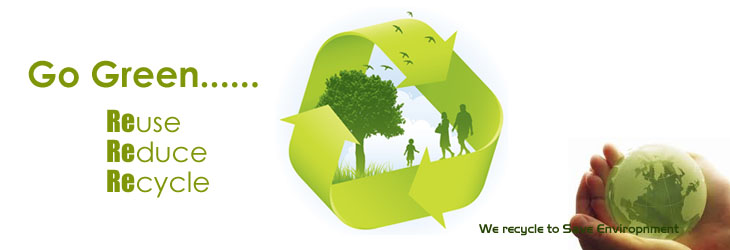Home » Pollution Control » Environment Guidelines

Environmental Guidelines
 Lead is the most recycled element among all of non-ferrous metals. More than 90% Lead worldwide is being recycled from Lead-Acid Battery Scrap which is tramendously increading day by day inaccord with advanced technology. Battery recycling industry is acknowledged worldwide as a model of product recycling. Eco-friendly battery recycling process prevents large nos. of Lead contents / dust & restore it for further process as well as this process saves energy and reduces environmental pollution as compared to primary production of Lead. It also facilitates recycling of other materials such as polypropylene battery casings etc.
Lead is the most recycled element among all of non-ferrous metals. More than 90% Lead worldwide is being recycled from Lead-Acid Battery Scrap which is tramendously increading day by day inaccord with advanced technology. Battery recycling industry is acknowledged worldwide as a model of product recycling. Eco-friendly battery recycling process prevents large nos. of Lead contents / dust & restore it for further process as well as this process saves energy and reduces environmental pollution as compared to primary production of Lead. It also facilitates recycling of other materials such as polypropylene battery casings etc.
As Lead is a hazardous metal, following environmental guidelines and eco-friendly business practices is important in Battery Recycling. Gravita has been fully committed to the environment and provides environment-friendly solutions since inception. All of Company’s business processes and operations are aligned with environmental aims. Developing more effective pollution control solutions and promoting modern pollution control technologies is one of our thrust areas. We provide plants integrated with efficient pollution control modules, at competitive capital costs, with the objective of widespread adoption of modern, eco-friendly designs and technologies.
Lead Emission Control
All processing industries generate waste. The quantities generated and their potential impacts depend on many factors, including the level of industrial development, the way in which wastes are managed, the existing state of the local environment and the capacity of the receiving media. The gases & fumes generated in the system are effectively controlled by the Pollution control Equipments. The amount of Lead content emitted with these gases is being collected at every stage of pollution control equipments.
- SOX – Sulphur content present in the gases are being treated with water
- CO, Lead Dust, Lead Ash etc. – These are controlled by different sections of Pollution Control Equipments.
- NOX – Not formed because of the lower level of temperatures of the furnace
Meeting Exacting Environmental Standards
Lead Emission Standards
Environmental standards relevant to the battery recycling industry vary widely among countries and international organizations and are in a constant state of flux. The main standards are:
Occupational Exposure-Intra Plant Lead in Air Limits |
| Main range of values for different countries |
0.05-0.15 mg/Nm3 |
|
| |
Ambient/Plant Perimeter Air Pollutants Limit Values (WHO recommendations)
Stack Emissions Standards
| Pollutant |
Standard/Maximum Emission Level |
 |
| Soot & Dust |
150 mg/Nm3 |
| Smoke |
Ringlemann 2 |
| Lead (Pb) & it’s Compounds |
10 mg/Nm3 as Pb |
Particulates (SPM)–Blast & Reverberatory Furnaces |
50 mg/Nm3 |
| Particulates (SPM)-Pot Furnaces |
10 mg/Nm3 |
|
| |
Effluent Discharge Standards
Parameter/
Substance |
Tolerance Limit Values |
 |
| |
Discharge into inland waters |
Discharge into coastal waters |
Discharge into public sewers |
| |
Sensitive waters |
General waters |
| pH |
6.0-8.5 |
6.0-9.0 |
5.5-9.0 |
5.5-10.0 |
| Total Suspended Solids |
20 mg/l max. |
50 mg/l max. |
150 mg/l max. |
500 mg/l max. |
| Lead (Pb) |
0.1 mg/l max. |
0.5 mg/l max. |
1.0 mg/l max. |
5.0 mg/l max. |
|
| |
Lead Content Limits for Solid Waste Disposal on Land
Cumulative
Limit |
Annual
Limit |
Soil
Concentration |
 |
| 1000 Kg/Ha |
33 Kg/Ha |
550 mg/Kg limit |
|
Maximum Permissible Noise Levels (At Plant Perimeter)
| Day Time(0600-1800 hrs) |
Night Time(1800-0600 hrs) |
 |
| 65db |
55db |
|
.
 Our plants are specifically designed to meet and exceed the relevant country’s environmental guidelines and standards. In addition, we provide suitable operating instructions and maintenance inputs. As a result, all our installations successfully meet the challenge of showing continuous environmental performance as per the design parameters. Our plants are specifically designed to meet and exceed the relevant country’s environmental guidelines and standards. In addition, we provide suitable operating instructions and maintenance inputs. As a result, all our installations successfully meet the challenge of showing continuous environmental performance as per the design parameters.
|





 Lead is the most recycled element among all of non-ferrous metals. More than 90% Lead worldwide is being recycled from Lead-Acid Battery Scrap which is tramendously increading day by day inaccord with advanced technology. Battery recycling industry is acknowledged worldwide as a model of product recycling. Eco-friendly battery recycling process prevents large nos. of Lead contents / dust & restore it for further process as well as this process saves energy and reduces environmental pollution as compared to primary production of Lead. It also facilitates recycling of other materials such as polypropylene battery casings etc.
Lead is the most recycled element among all of non-ferrous metals. More than 90% Lead worldwide is being recycled from Lead-Acid Battery Scrap which is tramendously increading day by day inaccord with advanced technology. Battery recycling industry is acknowledged worldwide as a model of product recycling. Eco-friendly battery recycling process prevents large nos. of Lead contents / dust & restore it for further process as well as this process saves energy and reduces environmental pollution as compared to primary production of Lead. It also facilitates recycling of other materials such as polypropylene battery casings etc.







